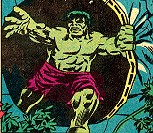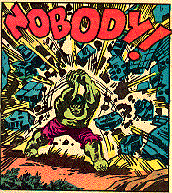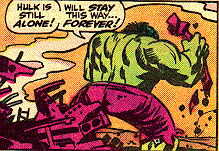

JH: You seem to like Marie Severin a lot. You started working on the HULK after her, right?
HT: I admire Marie immensely. I'm a big fan. Well, I picked up the Hulk from her in 1967. She did it, then I did it. I started at Marvel inking the westerns--Kid Colt and some other Western stuff.
JH: How did you end up drawing then?
HT: The inking petered out. The western stuff wasn't doing well, and there was less and less work. I was just preparing to put some material together and go to DC and Charlton when I got a call from Sol Brodsky who was production chief. He said they needed somebody on staff in the production department to run the new photostat machine they had just bought and to do some production work. I would primarily run the "stat" machine and wouldn't be seated at a desk, but I would be able to pick up some freelance pencilling and inking. This kind of opened the door. The staff job didn't pay much by today's standards, I think it started at $135 dollars a week which wasn't as low as it sounds. Remember, it was 1966 and that was a fairly good entry-level salary.
JH: In the beginning you were doing freelance inking on the westerns, how did that get started?
HT: John Verpoorten had been a classmate at SVA. When I got out of the Air Force in October of 1966, he worked in the production department at Marvel. He said they were hiring freelance people, and I should come up to the office and show my work to Sol Brodsky who was Stan's right-hand man at the time. I said, "Okay". Later, while I was in the photostat department, I did the Phantom Eagle freelance, the first book I penciled. I think.
JH: It was in Marvel Feature #16?
HT: Yeah. Gary Friedrich was the writer. "Groovy" Gary. We called him "Grooves" for short.
JH: You worked with him later on the Hulk?
HT: Yeah, I worked with him later, but I don't think we worked on the Hulk together. I think we did a Sgt. Fury, or two.
JH: The Phantom Eagle was his idea, but it seemed like he became your character.
HT: Everybody knew I liked airplanes, so Gary spun the idea off my fanatical interest. I was crazy about the idea of doing a World War One aviation story, but it was doomed from the beginning. Looking at it in retrospect, creating a World War One aviation combination superhero character was a nuts thing to do.
JH: What was the appeal in doing it? Weren't aviation war comics kind of dying out at that time? Were you trying to revive them?
HT: No, not at all. I just wanted to draw airplanes. Traditionally, I had always been a big EC fan, although I never really bought the books. My friends did, and I read them. My favorite guy was Jack Davis. I loved his aviation stories, along with George Evans', his World War One work, his western stuff, and his science fiction. That's where my interests were the strongest. As a kid, I loved Superman, and I loved Captain Marvel , also. The wackiest was Plastic Man. I loved it. Plastic Man was awesome. Those three characters were the extent of my superhero reading. I didn't buy those comics either. My cousin did, and I read them. That was before EC. I liked Disney comics, too, but like I said, the EC stuff was my favorite, Davis in particular.
JH: Stuff you read as a kid?
HT: Yeah.
JH: So ,while you were working in the production department at Marvel you were able to start inking. How long did it take to start drawing?
HT: As I mentioned before, the staff job opened the door. I worked in the production department about six months, I can't recall for sure. I was picking up freelance work here and there...Marie was doing the Hulk in Tales to Astonish, and they decided to give him his own book. Stan came into the stat room one day and asked me if I'd like to draw it. That was the end of the photostat job. He had other plans for Marie.
JH: You came in on the book as inker around issue #94.
HT: I don't think it was that early. (Correct me if I'm wrong.) I think I did one or two where she was involved, where I was the inker. Yeah, I think it was Tales to Astonish. I started drawing the Hulk in the low hundreds, after he had his own book.
JH: I think you started around #106.
HT: Something like that. I think the first actual complete book was #109, the one with Ka-Zar, where Frank Giacoia did the layouts. Stan wasn't satisfied with my layouts. I did three pages of that story, and Stan took one look and asked Frank to take over. Stan said, this is the way we want you to do it. I dumped the three pages that I had done in the trash. My story-telling wasn't bad, but the original layouts were more like EC stuff, dramatic and close-up. Stan wasn't really into that.
JH: But what about the few issues before that? In issue #106 you're given credit doing the breakdowns, and then in #107 and #108 you are given full credit for the artwork. Were you still completing breakdowns on those early issues?
HT: Boy, you got me on that. I really don't remember. Since I was being brought in to do the Hulk, brought up from the minors to the big leagues, so to speak, I might have gotten full credit as a morale boost, a kind of confidence builder, when in fact I had only a minimum amount of input in the areas you asked about.
JH: Did you also look to Kirby for influence?
HT: Everybody looked at Kirby. That was the idea. Buscema, Romita, everybody. Look at the Surfer. Look at Spider-Man. That's what Stan wanted. It didn't matter what your drawing style was like. They wanted everybody to do Kirby. It didn't matter what your drawing style was. To be fair, Stan was not asking us to draw like Kirby, to adopt Kirby's style as some did, but he wanted us to keep Kirby in mind in terms of telling the story. When Frank Giacoia did the Ka-Zar layouts, they were very Kirbyesque in terms of the drama of the story. The basic dramatics, the dynamics of the story itself wa It was very s a kind of in-your-face approach to storytelling. It was very important for the Marvel look.

JH: I think you kept some of that EC style though.
HT: I think you're right.
JH: If you look at your first twenty to thirty issues, you have lots of close-ups which gave the stories a moody atmosphere.
HT: I'm very happy it worked out that way.
JH: What about Marie Severin? Did she guide you at all while you were doing the Hulk? Give you any guidance?
HT: Not really. Stan was the overseer. He was the guy that made sure you stayed between the lines. And all the stories went through him. Roy Thomas was there at that point, but there was no intermediary. Basically, it was pretty much all Stan. You walked into his office for a story conference, and it was just you and him. That story conference was basically Stan telling you...[laughs] He might say "What did we do last time? Okay, how about this? That sounds good. Well, let's try that. Let's have him here," and on like that. At least that was pretty much my experience.
JH: He wasn't a hard scripter?
HT: No. I walked out of the office with nothing except what was in my head. I went out and wrote down as much as I could remember, whereas later with Roy, I would take some notes as he talked. He would talk, I would talk. We would both contribute. Roy pretty much had in mind where he wanted the story to go, but on occasion, my suggestion would wind up being a major thread in the plot. Each story was unto itself. We weren't doing endless continuing stories. With writers after Stan there was probably more input more the artist at the story's inception, but the creative freedom for the penciller came when the story was drawn. The penciller became the actors and director all at the same time. That creative concept was totally Stan's.
but on occasion, my suggestion would wind up being a major thread in the plot. Each story was unto itself. We weren't doing endless continuing stories. With writers after Stan there was probably more input more the artist at the story's inception, but the creative freedom for the penciller came when the story was drawn. The penciller became the actors and director all at the same time. That creative concept was totally Stan's.

LF: I think that's what made Marvel different back then.
HT: That was it.
LF: There was a simple plot and the artists did the storytelling.

JH: But when you look at Stan Lee's stuff, there's a lot of writing. A lot of editorializing. By contrast, the things I liked your work was that there were a lot of quiet moments. There were lots of quiet moments in your work where the Hulk was walking in nature. The story is told with no words at all, you read the story seeing how the Hulk interacts with the environment.
HT: That's probably one of the best things about it.
JH: It seemed like later on the Hulk changed. Writers came in with different approaches. How did you or the writers cope with the same character for so long?
HT: If you're asking why various writers and I didn't change the Hulk over an eight year period, it was because the character had a basic philosophy. We had no intention of changing it. We weren't into killing the characters off. You've got to understand, while I was doing the Hulk, it was the fourth or fifth top-selling book. If it ain't broke, don't fix it, as the saying goes. The whole marvel line wasn't more than twenty titles, including reprints. Sales figures for the Hulk was somewhere around a quarter of a million. If there had been royalties at the time, I'd be in the Bahamas right now. We sold a lot of books considering the market wasn't nearly as big as it got to be. There wasn't as much media attention in those days, either. Nobody had any idea the business would grow to the proportions that it did. That's when the corporate "suits" got hold of it, stripped it, and threw away the carcass. That, along with the weak leadership and terribly ineffective decisions at the editorial levels.
JH: My impression of the Hulk is that you had relative freedom to layout the story. How much of the Hulk was your creation?
HT: Of course, none of the the Hulk was my creation. It was Jack and Stan's creation. The Hulk, as nerd scientist Bruce Banner, was established. But everything an artist touches is influenced to some degree by that artist. I was able to put some of myself into the character. The basic philosophy of the Hulk was very powerful in terms of the pathos, and the business of the dual personality. I am a Gemini and have gone through some difficult personal times, both spiritually and emotionally. I think that was reflected in my Hulk.
JH: But in your Hulk stories, the Hulk was totally isolated. He roamed the world looking for companionship.
HT: The Hulk was an outcast. There are many in our society who are outcasts, people who are not accepted because they are different. I appreciated that about the Hulk, and it fit in with other outcasts you might find in literature, like Frankenstein's monster. The Hulk personified a condition that many people could identify with. The way the Hulk has been portrayed in recent years in ludicrous. We were directly inspired by the Frankenstein scenario in a story we did involving a little girl. It took place in an imaginary country in Eastern Europe.
JH: I think it was Hulk #133 and 134. "Draxon the Dictator!" These stories turned out to be huge hits with fans, who picked up on you and Roy re-interpreting the Hulk as Boris Karloff's Frankenstein. Was that a movie you enjoyed? Were there any other monster movies from that time you liked and can remember?
HT: Yes, I liked the movie a lot. It originally came out even before my time, 1931, I think. It used to make the rounds of local theaters periodically over the next several years. It came to Peekskill which was my home town, when I was about ten years old. They advertised an in-person appearance of the monster himself. I was too scared to go. I think the first time I saw it was back in the late fifties when I was in high school. It was shown on The Million Dollar Movie on WORTV, channel nine. Off the top of my head, another movie that was terrific, although not specifically a monster movie, was Invasion of the Body Snatchers, the original version. The remake was okay, but it was an entirely different movie from an entirely different time. The original was filled with political symbolisms. Remember, it was released during the McCarthy period in American politics when our obsession was the Red Menace.
